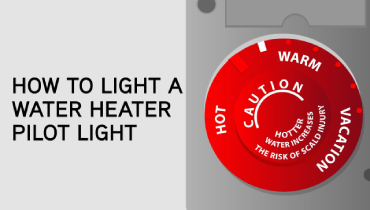
When a water heater pilot light goes out, it usually means that a natural change in gas pressure extinguished the flame. The main sign that a pilot light is out is one that everyone dreads: The water won’t get hot. It’s important to know how to light your water heater’s pilot light so you can get the flame going again as soon as possible, not only to get your hot showers back but also to make sure no gas gets accidentally released into the house in the event of a broken flame sensor.
Steps to Light a Water Heater Pilot Light
It's important to follow the instructions on your water heater; instructions vary from make and model. But for most gas-powered water heaters, you can start by finding the gas shut-off valve on the water heater first, which is usually labeled clearly on the front lower part of the water heater. Turn the knob to “Off,” and then wait five minutes for the gas to clear before you follow these steps:
- Open the door/cover over the pilot light access. This will be located under the gas valve; some water heaters just have an open gap instead of where you can see the pilot light burner.
- Use a flashlight or a headlamp to find the burner inside. Two small gas tubes will lead to it. You’ll want to watch it as you work.
- Turn the gas knob to “Pilot,” press, and hold it down. This will start the flow of gas so you can light the flame. Some water heaters have a separate button for pilot mode, usually a red one, which you’ll press and hold.
- While still holding the gas down, light that pilot. Some water heaters have a red or black igniting button, and others need to be lit manually with a long lighter.
- When the flame ignites, continue to hold the gas knob or button down for a full minute. Then release it slowly, and make sure the light is still lit.
- Turn the gas knob to “On,” and listen for the distinct “whump” or whooshing noise of the main burner ignites.
- Replace the cover and enjoy your hot shower.
Though a one-off extinguished pilot light is usually caused by a natural change in gas pressure, repeated malfunctions indicate a real problem with the water heater. The most common issue that leads to repeated pilot outages is a dirty or bent thermocouple, which is a small copper wire and rod that senses the flame and automatically turns the gas off when it detects a flame outage.
What is a Thermocouple?
In newer water heaters, a thermocouple is often referred to as a flame sensor. You probably have a bent, dirty or broken thermocouple if, after following the above lighting steps, the pilot light continues to go out. If it’s bent and isn’t near the burner, you can simply shut off the gas, move it over and try lighting the pilot again. If that doesn’t work, clean it: shut off both the water heater gas valve and the main gas line near the heater. Unscrew the three nuts that hold the thermocouple and the two gas tubes to the valve. The burner is usually easy to just slide out. Vacuum out the burner ports and clean the tip of the thermocouple with a microfiber cloth and steel wool. If this doesn’t take care of the problem, you can get a new thermocouple at any hardware store for under $15.
If your water heater seems to have more problems than you can handle, or if you’re ready for a more efficient model, you can contact your local Mr. Rooter Plumbing to restore hot water to your household. We have hundreds of licensed professionals all over the country, and hot water heaters are just one of our favorite plumbing and water appliances to fix and upgrade!

